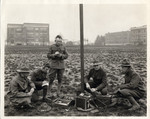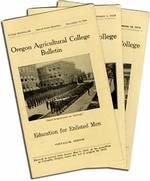
Early field radio training session with OAC Cadets, c. 1918. Very clear and detailed photo showing the early style wireless radio with cadets and training NCO. The caption on reverse in older fountain pen states: "Field Radio - or wireless Oregon Agricultural College, Corvallis" (SCARC)

Caption on reverse is typed on a small tag, stating "President Kerr addressing (sic) the S.A.T.C. (Student Army Training Corps) at the Inaugural Exercises, Oct. 1, 1918". The first four rows of crowd are cadets, with civilian onlookers in rear. (SCARC)

OAC issued bulletins to help students navigate the available government programs during and after the First World War. Subjects included SATC and classes for women in the college. (OSA, Oregon Defense Council Records, Publications and Ephemera, Box 8, Folder 4)
As the number of troops needed in Europe grew, the U.S. War Department needed to insure that a large number of officers and technical experts were able to be trained. They turned to college campuses across the nation with the Students Army Training Corps (SATC) program. In many cases US colleges already possessed the settings, equipment, and organization to train large numbers of students for military service. Oregon Agricultural College (and also University of Oregon) met the requirements of the War Department for participation. OAC’s program started in 1917 absorbed several existing programs, including Reserve Officers' Training Corps. Between 1917 and 1918, OAC was the center of military life for the entire state of Oregon and a total of 66 faculty members left to aid in the war effort.[1] In 1918 alone, the United States War Service called up another 105 staff members to active service. In total, almost 2,000 students, alumni, and faculty members were enlisted. On top of this, there were more than 2000 students registered on campus in the SATC.
Young men who were in the SATC could apply to one of two tracks of study if they met the following requirements:[2]
- Section A: Men at least 18 years old who had completed a grammar school education. These men studied trade and technical subjects analogous to college vocational courses.
- Section B: Men at least 18 years old who had completed a standard high school course of study. They could study either standard college courses or special war courses in engineering, mining, chemistry, physics, bacteriology, sanitation, and others.
The SATC students had to pay for their own books. However, they also received the usual soldier's pay of $30 per month and free tuition. They were also entitled to free room and board. But the campus was not previously setup to handle these additional men. “The colleges had to scramble to meet the housing and "mess" needs of the students. OAC hurried to erect a large barrack hall as well as a YMCA hall. But officials prepared to take further steps as needed, including requisitioning other college buildings, club houses, or private buildings. There is no objection, for example, to the taking over by the College of fraternity houses or private dormitories, or the conversion of other buildings for housing and subsistence purposes. The kind of building is not important provided that conditions are sanitary and healthful.”[3]
The addition of these men on campus changed the campus dynamic. “The sound of bugles became a regular part of campus life with the introduction of the Students Army Training Corps to the universities…Besides the sounds of bugles and drill calls, the previously quiet campus was jolted by other noises since it served double duty as training ground for battlefield tactics. The OTC students would light up the sky during ‘the occasional all night battle in the trenches with plenty of rockets and exploding of blank cartridges and 'bombs' and constantly playing searchlights picking out the scouting parties of either side, to make the battle realistic.’”[4]
But the presence of these men also affected the lives of the other co-eds on campus due to the rules which were instated because of their arrival on campus. "Among the changes are the limiting of week night 'dates' of sophomore, junior and senior women living in the houses of residence on the campus to one only. No more may upper class women have as many 'dates' as they wish on week nights. The new rules also did away with house dances at sorority houses and women's residence halls.”[5]
Despite the hope for a quick end to the war when the US entered in 1918, the government still needed prepare for a war which would last longer. To facilitate this, they intended to increase the army by two million men by July 1919, which they assumed meant the eventual mobilization of all able bodied registrants under the age of 21 by that time. OAC officials therefore cautioned students that "it cannot now be definitely stated how long a particular student will remain at college." The life of the student was very much in the hands of the military. Except for those engaged in technical studies of military value such as medicine, engineering, and chemistry, SATC students were not "in any sense a deferred or favored class."
In order to help supply the necessary men for the war effort, students in the B college program “were to be sorted and reassigned according to their preferences and qualifications. This process must have had a ‘clarifying’ and motivating effect on the intensity of their studies. Most fell into one of the following assignments:”[6]
- transfer to central officers training camp
- transfer to non-commissioned officers training school
- continued study at school for a limited time in a specified discipline
- assignment to vocational training school for technical training of military value
- transfer to cantonment for duty with troops as a private
Men in the A vocational program were to be "rated and tested by the standard Army methods and those who are found to possess the requisite qualifications may be assigned for further training in the collegiate section."[7]
But men weren’t the only students preparing for war on OAC’s campus. The following were some of the offerings:[8]
- a special nurses' aide training course. Upon completion the students were to see service both in the United States and overseas.
- a five month course in intensive civil service training. The university added faculty in its School of Commerce to accommodate the additional students.
- a course to train laboratory assistants to aid physicians and chemists in the service. The course was taught by the science department.
OAC encouraged women to train in traditional roles such as clerical, stenographic, and accounting positions, as well as food conservation and dietetics. “But the school also suggested that women "extend" to non-traditional fields such as engineering, mining, forestry, pharmacy, and factory supervision.”[9] However, the college tried to stray as little as possible from tradition and noted “’young women who are alert to their responsibilities’ would rise to the challenge created by war and ‘nothing so completely fits a young woman for these duties as a thorough course in home economics.’"[10]
